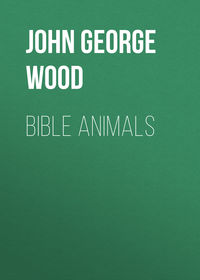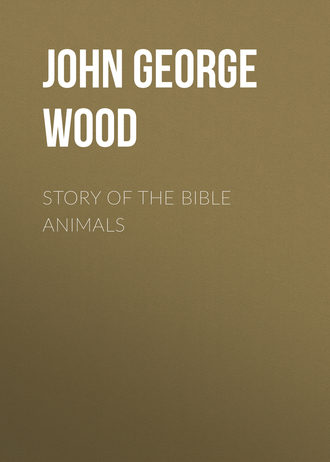 полная версия
полная версияStory of the Bible Animals
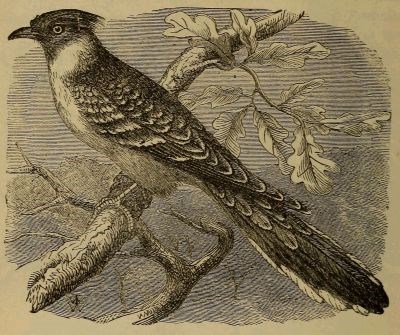
THE GREAT SPOTTED CUCKOO.
Besides this species, another Cuckoo inhabits Palestine, and is much more common. This is the Great Spotted Cuckoo (Oxylophus glandarius). The birds belonging to this genus have been separated from the other Cuckoos because the feathers on the head are formed into a bold crest, in some species, such as Le Vaillant's Cuckoo, reminding the observer of the crest of the cockatoo. This fine bird measures nearly sixteen inches in length, and can be distinguished, not only by the crested head, but by the reddish grey of the throat and chest, and the white tips of the wing and tail feathers.
This species lays its eggs in the nests of comparatively large birds, such as the rooks, crows, and magpies.

NOAH RECEIVES THE DOVE.
THE DOVE
Parallel between the lamb and the Dove—The Dove and the olive branch—Abram's sacrifice, and its acceptance—The Dove-sellers of the Temple—The Rock Dove and its multitudes.
In giving the Scriptural history of the Doves and Pigeons, we shall find ourselves rather perplexed in compressing the needful information into a reasonable space. There is no bird which plays a more important part, both in the Old and the New Testaments, or which is employed so largely in metaphor and symbol.
The Doves and Pigeons were to the birds what were the sheep and lambs to the animals, and, like them, derived their chief interest from their use in sacrifice. Both the lamb and the young pigeon being emblems of innocence, both were used on similar occasions, the latter being in many instances permitted when the former were too expensive for the means of the offerer. As to the rendering of the Hebrew words which have been translated as Pigeon, Dove, and Turtle Dove, there has never been any discussion. The Hebrew word yonâh has always been acknowledged to signify the Dove or Pigeon, and the word tôr to signify the Turtle Dove. Generally, the two words are used in combination, so that tor-yonâh signifies the Turtle Dove.
Though the interpretation of the word yonâh is universally accepted, there is a little difficulty about its derivation, and its signification apart from the bird. Some have thought that it is derived from a root signifying warmth, in allusion to the warmth of its affection, the Dove having from time immemorial been selected as the type of conjugal love. Others, among whom is Buxtorf, derive it from a word which signifies oppression, because the gentle nature of the Dove, together with its inability to defend itself, cause it to be oppressed, not only by man, but by many rapacious birds.
The first passage in which we hear of the Dove occurs in the earlier part of Genesis. Indeed, the Dove and the raven are the first two creatures that are mentioned by any definite names, the word nachosh, which is translated as "serpent" in Gen. iii. 1, being a collective word signifying any kind of serpent, whether venomous or otherwise, and not used for the purpose of designating any particular species.
Turning to Gen. viii. 8, we come to the first mention of the Dove. The whole passage is too familiar to need quoting, and it is only needful to say that the Dove was sent out of the ark in order that Noah might learn whether the floods had subsided, and that, after she had returned once, he sent her out again seven days afterwards, and that she returned, bearing an olive-branch (or leaf, in the Jewish Bible). Seven days afterwards he sent the Dove for the third time, but she had found rest on the earth, and returned no more.
It is not within the province of this work to treat, except in the most superficial manner, of the metaphorical signification of the Scriptures. I shall, therefore, allude but very slightly to the metaphorical sense of the passages which record the exit from the ark and the sacrifice of Noah. Suffice it to say that, putting entirely aside all metaphor, the characters of the raven and the Dove are well contrasted. The one went out, and, though the trees were at that time submerged, it trusted in its strong wings, and hovered above the watery expanse until the flood had subsided. The Dove, on the contrary, fond of the society of man, and having none of the wild, predatorial habits which distinguish the raven, twice returned to its place of refuge, before it was finally able to find a resting-place for its foot.
After this, we hear nothing of the Dove until the time of Abraham, some four hundred years afterwards, when the covenant was made between the Lord and Abram, when "he believed in the Lord, and it was counted to him for righteousness." In order to ratify this covenant he was ordered to offer a sacrifice, which consisted of a young heifer, a she-goat, a ram, a turtle-dove, and a young dove or pigeon. The larger animals were severed in two, but the birds were not divided, and between the portions of the sacrifice there passed a lamp of fire as a symbol of the Divine presence.
In after days, when the promise that the seed of Abram should be as the stars of heaven for multitude had been amply fulfilled, together with the prophecy that they should be "strangers in a land that was not theirs," and should be in slavery and under oppression for many years, the Dove was specially mentioned in the new law as one of the creatures that were to be sacrificed on certain defined occasions.
Even the particular mode of offering the Dove was strictly defined. See Lev. i. 14-17: "If the burnt sacrifice for his offering to the Lord be of fowls, then he shall bring his offering of turtle-doves, or of young pigeons.
"And the priest shall bring it unto the altar, and wring off his head, and burn it on the altar; and the blood thereof shall be wrung out at the side of the altar.
"And he shall pluck away his crop with his feathers, and cast it beside the altar, on the east part, by the place of the ashes.
"And he shall cleave it with the wings thereof, but shall not divide it asunder: and the priest shall burn it upon the altar, upon the wood that is upon the fire."
Here we have a repetition not only of the sacrifice of Abram, but of the mode in which it was offered, care being taken that the body of the bird should not be divided. There is a slight, though not very important variation in one or two portions of this passage. For example, the wringing off the head of the bird is, literally, pinching off, and had to be done with the thumb nail; and the passage which is by some translators rendered as the crop and the feathers, is by others translated as the crop and its contents—a reading which seems to be more consonant with the usual ceremonial of sacrifice than the other.
As a general rule, the pigeon was only sanctioned as a sacrificial animal in case one of more value could not be afforded; and so much care was taken in this respect, that with the exception of the two "sparrows" (tzipporim) that were enjoined as part of the sacrifice by which the cleansed leper was received back among the people (Lev. xiv. 4), no bird might be offered in sacrifice unless it belonged to the tribe of pigeons.
It was in consequence of the poverty of the family that the Virgin Mary brought two young pigeons when she came to present her new-born Son in the Temple. For those who were able to afford it, the required sacrifice was a lamb of the first year for a burnt-offering, and a young pigeon or Turtle Dove for a sin-offering. But "if she be not able to bring a lamb, then she shall bring two turtles, or two young pigeons, the one for the burnt-offering and the other for a sin-offering." The extraordinary value which all Israelites set upon the first-born son is well known, both parents even changing their own names, and being called respectively the father and mother of Elias, or Joseph, as the case may be. If the parents who had thus attained the summit of their wishes possessed a lamb, or could have obtained one, they would most certainly have offered it in the fulness of their joy, particularly when, as in the case of Mary, there was such cause for rejoicing; and the fact that they were forced to substitute a second pigeon for the lamb is a proof of their extreme poverty.
While the Israelites were comparatively a small and compact nation, dwelling around their tabernacle, the worshippers could easily offer their sacrifices, bringing them from their homes to the altar. But in process of time, when the nation had become a large and scattered one, its members residing at great distances, and only coming to the Temple once or twice in the year to offer their sacrifices, they would have found that for even the poor to carry their pigeons with them would have greatly increased the trouble, and in many cases have been almost impossible.
For the sake of convenience, therefore, a number of dealers established themselves in the outer courts of the Temple, for the purpose of selling Doves to those who came to sacrifice. Sheep and oxen were also sold for the same purpose, and, as offerings of money could only be made in the Jewish coinage, money-changers established themselves for the purpose of exchanging foreign money brought from a distance for the legal Jewish shekel. That these people exceeded their object, and endeavoured to overreach the foreign Jews who were ignorant of the comparative value of money and goods, is evident from the fact of their expulsion by our Lord, and the epithets which were applied to them.
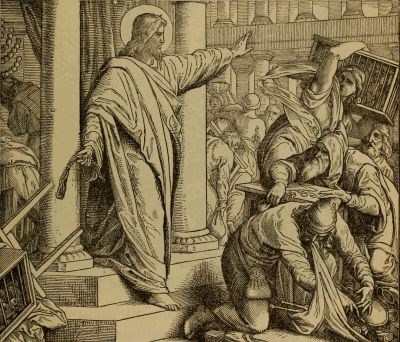
JESUS DRIVES OUT OF THE TEMPLE THE MONEY-CHANGERS AND THOSE WHO SOLD DOVES.
According to some old writers, the Dove was considered as having a superiority over other birds in the instinctive certainty with which it finds its way from one place to another. At the present time, our familiarity with the variety of pigeon known as the Carrier has taught us that the eye is the real means employed by the pigeon for the direction of its flight. Those who fly pigeons for long distances always take them several times over the same ground, carrying them to an increasing distance at every journey, so that the birds shall be able to note certain objects which serve them as landmarks.
Bees and wasps have recourse to a similar plan. When a young wasp leaves its nest for the first time, it does not fly away at once, but hovers in front of the entrance for some time, getting farther and farther away from the nest until it has learned the aspect of surrounding objects. The pigeon acts in precisely the same manner, and so completely does it depend upon eyesight that, if a heavy fog should come on, the best-trained pigeon will lose its way.
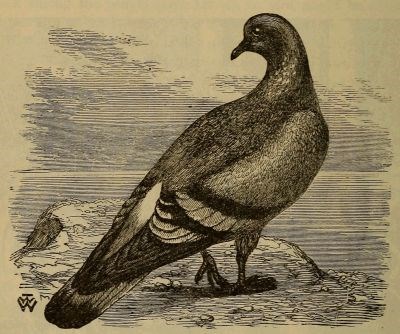
THE ROCK DOVE.
The old writers, however, made up their minds that the pigeon found its way by scent, which sense alone, according to their ideas, could guide it across the sea. They were not aware of the power possessed by birds of making their eyes telescopic at will, or of the enormous increase of range which the sight obtains by elevation. A pigeon at the elevation of several hundred yards can see to an astonishing distance, and there is no need of imagining one sense to receive a peculiar development when the ordinary powers of another are sufficient to obtain the object.
That dove-cotes were in use among the earlier Jews is well known. An allusion to the custom of keeping pigeons in cotes is seen in Isa. lx. 8: "Who are these that fly as a cloud, and as the doves to their windows?" or, as the Jewish Bible translates the passage, "as the doves to their apertures?" In this passage the sacred writer utters a prophecy concerning the coming of the world to the Messiah, the Gentiles flocking to Him as the clouds of pigeons fly homeward to their cotes.
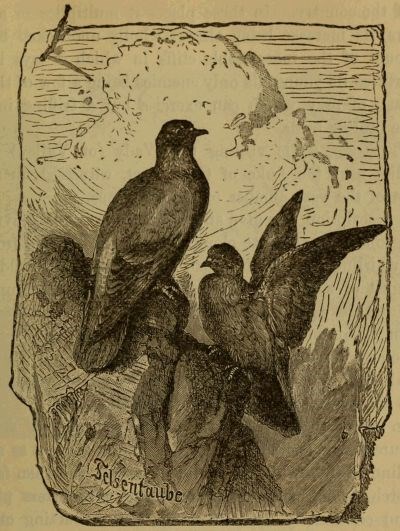
BLUE ROCK PIGEONS.
The practice of pigeon-keeping has survived to the present day, the houses of wealthy men being furnished with separate pigeon-houses for the protection and shelter of these popular birds.
In the Holy Land are found all the species of Pigeons with which we are familiar, together with one or two others. First, there is the Rock Pigeon, or Blue Rock Dove, which is acknowledged to be the origin of our domestic breeds of Pigeons, with all their infinite variety of colour and plumage. This species, though plentiful in Palestine, is not spread over the whole of the land, but lives chiefly on the coast and in the higher parts of the country. In these places it multiplies in amazing numbers, its increase being almost wholly unchecked by man, on account of the inaccessible cliffs in which it lays its eggs and nurtures its young, its only enemies being a few of the birds and beasts of prey, which can exercise but a trifling influence on these prolific birds.
Mr. Tristram, while visiting the Wady (or Valley) Seimûn, which lies near the Lake of Gennesaret, witnessed an amusing example of the vast number of these Pigeons.
"No description can give an adequate idea of the myriads of rock pigeons. In absolute clouds they dashed to and fro in the ravine, whirling round with a rush and a whirr that could be felt like a gust of wind. It was amusing to watch them upset the dignity and the equilibrium of the majestic griffon as they swept past him. This enormous bird, quietly sailing along, was quite turned on his back by the sudden rush of wings and wind."
In Palestine these birds are taken in nets, into which they are decoyed by a very effective though cruel device.
When one of these birds is trapped or snared, it is seized by its capturers, who spare its life for the sake of using it as a decoy. They blind it by sewing its eyelids together, and then fasten it to a perch among trees. The miserable bird utters plaintive cries, and continually flaps its wings, thus attracting others of its kind, who settle on the surrounding branches and are easily taken, their whole attention being occupied by the cries of their distressed companion.
We now come to the Turtle Doves, several of which inhabit the Holy Land; but, as they are similar in habits, we will confine ourselves to the common species, with which we are so familiar in this country. Its migratory habits are noticed in the sacred writings. See the following passage in the Song of Solomon:
"Lo, the winter is past, the rain is over and gone; the flowers appear on the earth; the time of the singing of birds is come, and the voice of the turtle is heard in our land" (Cant. ii. 11, 12). The prophet Jeremiah also refers to the migration of this bird: "Yea, the stork in the heaven knoweth her appointed times; and the turtle, and the crane, and the swallow observe the time of their coming; but my people know not the judgment of the Lord" (viii. 7).
Beside this species, there is the Collared Turtle Dove, one variety of which is known as the Barbary Dove. It is a large species, measuring more than a foot in length. Another species is the Palm Turtle, so called from its habit of nesting on palm-trees, when it is obliged to build at a distance from the habitations of man. It is a gregarious bird, several nests being generally found on one tree, and even, when it cannot find a palm, it will build among the thorns in multitudes. Like the common Dove, it is fond of the society of man, and is sure to make its nest among human habitations, secure in its knowledge that it will not be disturbed.
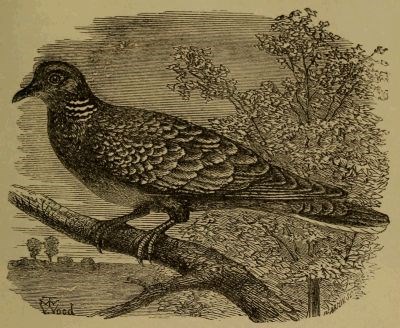
THE TURTLE DOVE.
It is rather a small bird, being barely ten inches in length, and having no "collar" on the neck, like the two preceding species.

POULTRY
Poultry plentiful in Palestine at the present day—The Domestic Fowl unknown in the early times of Israel—The eating and gathering of eggs—References to Poultry in the New Testament—The egg and the scorpion—The fatted fowl of Solomon—The hen brooding over her eggs—Poultry prohibited within Jerusalem—The cock-crowing.
At the present day, poultry are plentiful both in Palestine and Syria, and that they were bred in the time of the Apostles is evident from one or two references which are made by our Lord. How long the Domestic Fowl had been known to the Jews is extremely uncertain, and we have very little to guide us in our search.
That it was unknown to the Jews during the earlier period of their history is evident from the utter silence of the Old Testament on the subject. A bird so conspicuous and so plentiful would certainly have been mentioned in the Law of Moses had it been known to the Israelites; but, in all its minute and detailed provisions, the Law is silent on the subject.
Neither the bird itself nor its eggs are mentioned, although there are a few references to eggs, without signifying the bird which laid them. The humane provision in Deut. xxii. 6, 7, refers not to a domesticated, but to a wild bird: "If a bird's nest chance to be before thee in any tree, or on the ground, whether they be young ones, or eggs, and the dams sitting upon the young, or upon the eggs, thou shalt not take the dam with the young: but thou shalt in any wise let the dam go, and take the young to thee; that it may be well with thee, that thou mayest prolong thy days."
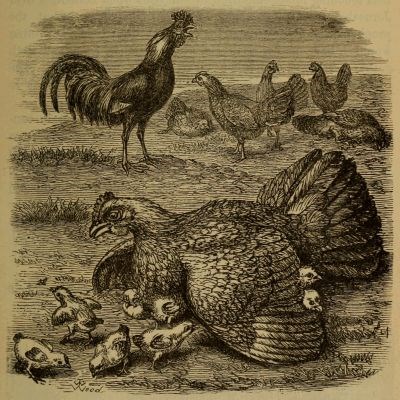
THE DOMESTIC FOWL.
There is but one passage in the Old Testament which has ever been conjectured to refer to the Domestic Fowl. It occurs in 1 Kings iv. 22, 23: "And Solomon's provision for one day was thirty measures of fine flour, and threescore measures of meal,
"Ten fat oxen, and twenty oxen out of the pastures, and an hundred sheep, besides harts, and roebucks, and fallow-deer, and fatted fowl."
Many persons think that the fatted fowl mentioned in the above-quoted passage were really Domestic Fowl, which Solomon had introduced into Palestine, together with various other birds and animals, by means of his fleet. There may be truth in this conjecture, but, as there can be no certainty, we will pass from the Old Testament to the New.
We are all familiar with the passages in which the Domestic Fowl is mentioned in the New Testament. There is, for example, that touching image employed by our Lord when lamenting over Jerusalem: "O Jerusalem, Jerusalem, thou that killest the prophets, and stonest them that are sent unto thee; how often would I have gathered thy children together, as a hen doth gather her brood under her wings, and ye would not!" The reference is evidently made to the Domesticated Fowl, which in the time of our Lord was largely bred in the Holy Land.
Some writers have taken objection to this statement in consequence of a Rabbinical law which prohibited poultry from being kept within the walls of Jerusalem, lest in their search for food they should scratch up any impurity which had been buried, and so defile the holy city. But it must be remembered that in the time of Christ Jerusalem belonged practically to the Romans, who held it with a garrison, and who, together with other foreigners, would not trouble themselves about any such prohibition, which would seem to them, as it does to us, exceedingly puerile, not to say unjustifiable.
That the bird was common in the days of our Lord is evident from the reference to the "cock-crowing" as a measure of time.
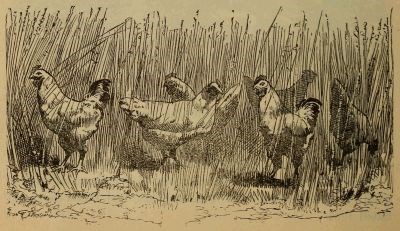

THE PEACOCK
The foreign curiosities imported by Solomon—The word Tucciyim and its various interpretations—Identity of the word with the Cingalese name of the Peacock—Reasons why the Peacock should have been brought to Solomon—Its subsequent neglect and extirpation.
Among the many foreign objects which were imported by Solomon into Palestine, we find that the Peacock is specially mentioned. (See a passage which has already been mentioned in connexion with ivory and apes.) The sacred historian, after mentioning the ivory throne, the golden shields and targets, that all the vessels in Solomon's house were of gold, and that silver was so common as to be of no account, proceeds to give the reason for this profuse magnificence. "For the king had at sea a navy of Tharshish with the navy of Hiram: once in three years came the navy of Tharshish, bringing gold, and silver, ivory, and apes, and peacocks" (1 Kings x. 22).
That this magnificent bird should have been one of those creatures that were imported by Solomon is almost certain. It would be imported for the same reason as the apes; namely, for the purpose of adding to the glories of Solomon's house, and no bird could have been selected which would have a more magnificent effect than the Peacock. Moreover, although unknown in Palestine, it is extremely plentiful in India and Ceylon, inhabiting the jungle by thousands, and, by a curious coincidence, being invariably most plentiful in those spots which are most frequented by tigers. In many parts of the country, great numbers of Peacocks frequent the temples, and live amicably with the sacred monkeys, passing their lives in absolute security, protected by the sanctity of the place.
Their numbers, therefore, would render them easily accessible to Solomon's envoys, who would purchase them at a cheap rate from the native dealers, while their surpassing beauty would render them sure of a sale on their arrival in Jerusalem. Indeed, their beauty made so great an impression that they are separately mentioned by the sacred chronicler, the Peacock and the ape being the only two animals that are thought worthy of enumeration.
The Peacock may safely be termed one of the most beautiful of the feathered tribe, and may even lay a well-founded claim to the chief rank among birds, in splendour of plumage and effulgence of colouring.
We are so familiar with the Peacock that we think little of its real splendour; but if one of these birds was brought to this country for the first time, it would create a greater sensation than many animals which are now viewed in menageries with the greatest curiosity and interest.
The train of the male Peacock is the most remarkable feature of this beautiful bird; the feathers composing it are very long, and are coloured with green, purple, bronze, gold, and blue in such a manner as to form distinct "eyes."
On the head is a tuft of upright feathers, blackish upon their shafts, and rich golden green, shot with blue, on their expanded tips. The top of the head, the throat, and neck are the most refulgent blue, changing in different lights to gold and green. The wings are darker than the rest of the plumage, the abdomen blackish, and the feathers of the thighs are fawn.
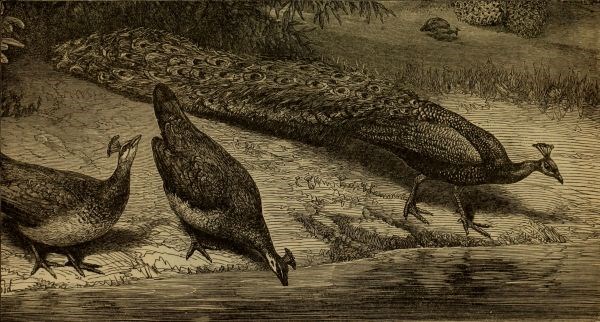
THE PEACOCK.
The female is much smaller than her mate, and not nearly so beautiful, the train being almost wanting, and the colour ashy-brown, with the exception of the throat and neck, which are green.
It seems that after Solomon's death the breed of Peafowl was not kept up, owing in all probability to the troubles which beset the throne after that magnificent monarch died.


THE PARTRIDGE
The word Kore and its signification—The Partridge upon the mountains—David's simile—The Desert Partridge and its habits—Hunting the Partridge with sticks—Eggs of the Partridge—Egg-hunting in Palestine—The various species of Partridge.



